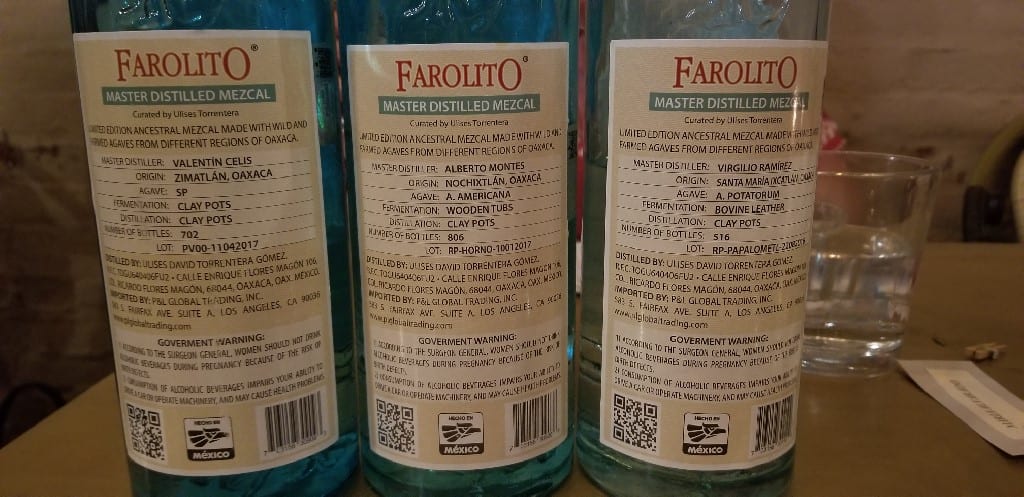
05 Sep A new perspective on Mezcal
Whenever I thought of Mezcal, I thought of it as a smokey version of Tequila. I know that Tequila and Mezcal are different spirits, both made from agave, but I was never a fan of the smokiness. But then I met mezcal connoisseur Ulises Torrentera and tasted his Farolito Mezcals, and I have a completely new perspective on Mezcal which I wrote about in the Napa Valley Register and you can read here.
There is the saying, “wine is life.” But in Oaxaca, Mexico, “mezcal is life.” I am not talking about tequila, which is a type of mezcal. I am talking about mezcal, a liquor that can be made from more than 30 varieties of agave and is cooked inside earthen pits lined with lava rocks and then distilled in clay pots.
Mezcal is produced in nine areas of Mexico, which include Durango, Guanajuato, Guerrero, San Luis Potosi, Tamaulipas, Zacatecas, Michoacán, Puebla and Oaxaca, where more than 85 percent of all mezcal is made.
I had always thought of mezcal as a very smoky spirit that was not my favorite. But, after meeting Ulises Torrentera, the legendary mezcal connoisseur, I have a completely different perspective on mezcal.
In fact, what I found most interesting about mezcal is that it has similarities with wine. As wine can be made from different grape varieties, mezcal is made from different varieties of agave. And as we like to discuss the terroir of a wine, you can do the same with mezcal.
Of the nine regions where mezcal can be made, each region produces mezcal with a different feel and taste. This is because each region has unique climates, with deserts in the north, forests in the center and coastal influences in the south.
Like grape varieties, each agave variety takes a different length of time to mature, although an agave plant matures over multiple growing seasons and grapes grow in one season.
Despite mezcal’s complexity, it has been misunderstood for years. It was once thought of as Mexico’s poor, rural drink. As Torrentera explained, mezcal is a story of persecution. During the Spanish Revolution, the Church told the Mexicans that they would be excommunicated if they made mezcal, as more European-style spirits were preferred.
Fortunately, many Mexicans continued to make mezcal in secret. These Mezcaleros as the guardians of tradition. They have protected the art of making mezcal and are producing a product made from recipes that were passed down generation to generation.
Ulises Torrentera, the author of two influential books on mezcal, is also the co-owner of the Oaxacan mezcaleria In Situ with his partner Sandra Ortiz Brenna.
Torrentera is spreading the word about traditional mezcal, celebrating the mezcaleros and their family recipes. And to share these mezcals with the U.S., he created Farolito, a brand in which Torrentera curates limited-edition, ancestral mezcal, made with wild and farmed agaves from different regions in Oaxaca.
Torrentera has spent decades touring palenques (distilleries) in the different regions of Oaxaca and beyond. Each of the mezcals that he bottles is from small batches.
On a recent visit to the U.S., Torrentera brought with him three mezcals, each made from a different mezcalero, from different agave and from different regions. What the three mezcals have in common is that they are all roasted on the ground and then distilled in clay. These are all artisanal, ancestral mezcals that express the culture of the mezcalero.
Farolito Penca Verde is made with agave Penca Verde, which means “green apple” and on the bottle it is labeled “Agave Sp,” which means it is an unclassified species.
This mezcal is made by maestro mezcalero Valentin Celis in Zimatlan, Oaxaca. The agave is grown in a forested area. The agave is cooked and crushed, fermented in clay pots and then distilled in a small clay pot still. The mezcal has a sweet nose of tropical fruit and herbs and is smooth and delicate on the palate.
Farolito Horno is made with an agave Americana by Alberto Montes in Nochixtlan, Oaxaca. This agave comes from an arid desert climate. The agave is cooked and crushed and then fermented in wooden tubs and distilled in clay pot stills. Only 806 bottles were produced of this richer mezcal that is sweet and smooth.
Farolito Papalometl is made with agave Papalometl (potatorum) in Santa Maria Ixcatlan, Oaxaca. This agave comes from an area where there is lots of rain and humidity and the soils are organic. The agave, which takes 18 years to maturation, is cooked and crushed and then fermented in bovine leather.
Bovine leather are large cow hides that traditionally were used because they were easy to hide from the Spanish when the Mexicans were banned from making mezcal.
Bovine leather can be used and reused for many years.
Once the agave is fermented, it is double distilled in small clay pots. The resulting mezcal is spicy with notes of brown sugar, nutmeg and chilis.
Mezcal is a far more nuanced category than I had ever expected. Never again will I assume mezcal is the smokier version of tequila but when I am seeking a mezcal, I will always be sure to look for one that is artisanal. Because, like wine, terroir matters, as does the process of how it is made.
Read the original story in the Napa Valley Register.
Discover more from Please The Palate
Subscribe to get the latest posts sent to your email.





